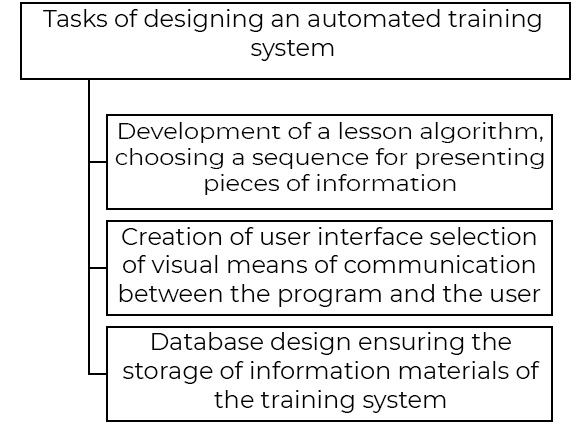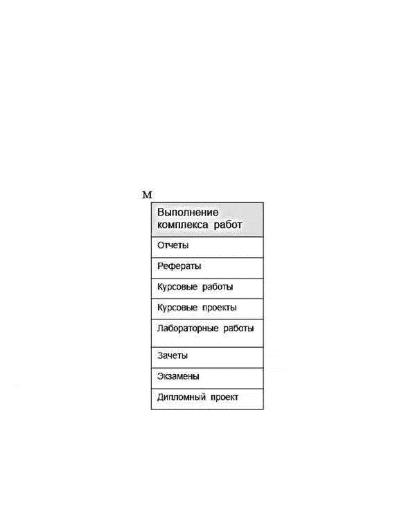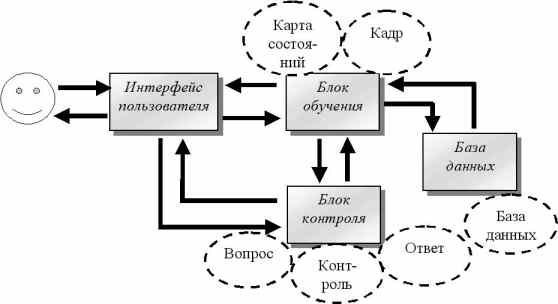Abstract
Attention! At the time of this writing, the master's work has not been completed. Estimated completion date - May 2021. The full text of the work, as well as materials on the topic can be obtained from the author or his manager after that date.
Contents
- Introduction
- 1. Theme urgency
- 2. Goal and tasks of the research, expected outcomes
- 3. Overview of research and development
- 3.1 Overview of national sources
- 3.2 Overview of international sources
- 3.3 Overview of local sources
- 4. Principles of computer-aided design of a training system
- Conclusions
- References
Introduction
Today, e-learning is used everywhere, implementing the technology of continuous education. The presence of demand for learning management systems (English Learning Management System, LMS) naturally gives rise to many proposals, creating the problem of choosing the best. According to the Edutechnica team, the most common in the world are Blackboard, Moodle and Canvas.
One of the main trends in the development of automated training systems is their intellectualization, those. the ability of the system to adapt the level of presentation of educational material to the individual abilities and capabilities of the student. In this regard, the task of identifying the main components of intelligent learning systems and their further software implementation is urgent.
In general, training programs are considered intelligent if they have the ability to: generate training tasks; solve the problems presented to the student using methods of representing knowledge about the studied discipline; define a strategy and dialogue tactics; to simulate the state of knowledge of the student; self-study based on the analysis of the results of interaction with students.
1. Theme urgency
The emergence of the expert systems MYCIN, DENDRAL, PROSRESTOR, and also the encouraging results of their successful application in the field medicine, technical diagnostics, geophysics, continuous technological processes have drastically changed the situation. Has become obvious that methods of plausible and deductive inference can be a good addition or partial replacement of a specialist who puts medical or technical diagnosis and general decision-maker in form of choosing one of the alternative hypotheses based on the observed data.
The master's thesis is devoted to the actual scientific task of developing a new automated training system by ordinary differential equations of the first order. The system under consideration covers most sections of the topic being studied, allows you to observe the progress and the process of studying the educational material by students, check completed tasks for relevance. The intellectual component in the training system will allow you to create unique training programs that will build on existing knowledge and the level of perception of educational material learners. It is proposed to use the analysis of expert systems as mathematical methods.
2. Goal and tasks of the research, expected outcomes
Modern intelligent training systems have various algorithms for intellectualization. The purpose of their use is to conduct the process of teaching natural science subjects. They have the functionality of evaluating the step of the user's decision process according to the criterion "right" and "wrong". In addition, such intelligent teaching systems provide the possibility of hints indicating incorrect the user's step or on his further actions. An integral function of such systems is that they exhibit assessments based on the results of the course. When a system of this class is operating, the user decision process is checked. on the criteria of completeness and correctness. These criteria are checked by comparing the user's decision steps and steps, which are set on the system by default.
When implementing the adaptation process in intelligent learning systems, one of the most important points is the choice of mathematical methods.
In this work, the task is to develop a modern intelligent teaching system using models and algorithms based on the analysis of existing methods in the field of mathematical models. The implementation of the task is based on using methods and means of computer information technology.
In accordance with the set goal, a number of tasks are solved in the work:
- Research of mathematical models for their introduction into the system
- Justification of the feasibility of creating models and algorithms for SIOS
- Formation of key requirements to be met by the developed models and algorithms.
- Choosing an appropriate teaching method based on the learner's level of knowledge and preferred learning style
- Identifying student misunderstandings and reacting accordingly
- Tasks related to checking the level of knowledge, skills and abilities of students before and after training, their individual abilities and motivations;
- Tasks of system administration, delivery of educational material to workstations and tasks of feedback to the student.
- Tasks of AOC related to the preparation and presentation of educational material, adaptation of the material by difficulty levels, preparation dynamic illustrations, control tasks, laboratory work, students' independent work;
- Tasks related to the registration and statistical analysis of indicators of the assimilation of educational material: determining the time for solving problems, determining the total number of errors, etc. The tasks of managing educational activities also belong to this group;
- Determination of the features and functions of automated control implemented in ITS in the context of creating complex algorithms analysis of trainees' responses
The object of research is focused on the creation of human-machine, or, as they say - interactive, intelligent systems. The most important problem in these studies is the organization of semantically flawless dialogue between a person and such a system.
3. Overview of research and development
An approach to the unification of synthesis of Moore FSM on FPGA is offered in article [1]. It joints several possibilities of optimization and is directed on FPGA (fig. 1). Entity of an approach consists in sequential application of algorithmic, combinatory and circuitry stages and using FPGA-oriented tools: CAD and HDLs.
3.1 Overview of national sources
Research into the automation of the pedagogical process began in the late 60s of the XX century, as well as the first attempts to create automated training systems (AOS). Based on actively developing in the late 60s - early 70s of the concept of programmed learning (in particular, research by P.Ya. Galperin [ 1 ], N.F. Talyzina [ 2 ], V.P. Bespalko [ 3 ] and others), the first attempts of complex analysis were made automation of various pedagogical processes.
AOC Contact
was created by the team of the Riga Polytechnic Institute under the leadership
L.V. Nicetsky in the late 60s on the basis of computers Minsk-32
terminals were used
electric typewriters, teleprinters and displays [ 4 ]. The program monitored the knowledge of the complex
questions previously entered into its database;
In the 80s, the first experiments on the introduction of AOC in universities, vocational schools and schools (Novosibirsk, Kiev, Tbilisi, Moscow) began [ 5 ]. The first methodological guidelines for the use of AOC in universities and secondary specialized educational institutions are being drawn up [ 6 - 9 ].
Over time, the first AOS appear that create a model of the student and the subject area; they are called expert or intelligent systems [ 10 ]. Such systems adapt content education to the student's goals and attainment by creating a student model [ 11 ].
3.2 Overview of international sources
The first stage of studying the possibilities of creating training systems falls on 50s and 60s of the twentieth century. Professor B.F. & nbsp; Skinner in 1954 put forward the idea, dubbed programmed learning [ 12 ]. It was to call improve the efficiency of educational process management by building it in full accordance with psychological knowledge about him, which actually means the introduction cybernetics in teaching practice [ 13 ]. This direction began to develop actively in the USA, and then in other countries. And even then one of the main signs programmed learning was considered the automation of the learning process.
in the 60s, a large number of specialized software packages focused on the creation and maintenance of applied training programs - automated training courses (AUK) based on a computer of the third generation. Some of the most famous projects in our country for the use of computing technology and means of communication in teaching is the PLATO project in the most developed versions - PLATO-IV, as well as domestic automated training systems (AOS) AOS-VUZ, AOS-SPOK, ASTRA, SADKO and some others.
In addition to systems of the selective type, producing training systems were created, in which dialogue with the trainee is not programmed, but is formed by several algorithms in accordance with a set of operations and facts embedded in the system. Similar training systems were intended for some specific subject areas, which, for one reason or another, turned out to be extremely suitable for such type of programming. Examples include the Licklider system for analytic geometry training [ 14 ] and the Biten and Lane system teaching the pronunciation of words in a foreign language [ 15 ].
3.3 Overview of local sources
As a result of a review of the work of students of Donetsk National Technical University It was found that some students also dealt with issues related to customer satisfaction:
- Tsibulsky G.M., Gerasimova E.I., Eroshin V.V. Learning Models for Automated Learning Systems [ 16 ].
- Kh.N. Timergalin, SN Kol Automated training systems and dynamic simulation models as the basis of modern distance learning [ 17 ].
- Melnikov A.V., ass. Tsytovich P.L. Basic principles of design automation of a training system based on the object-container approach [ 18 ].
However, the issues of using mathematical methods in the creation of intelligent learning systems were previously covered, although they have a number of significant differences associated with their introduction into the system.
4. Principles of design automation of a training system
Currently, software technologies based on personal computers are being actively introduced into the learning process, used to transfer educational material to the student and control the degree of its assimilation. Moreover, on the market over the past decade, a large number of training systems have appeared, including automated (AOC), which cover various subject areas, and are designed to solve learning problems on at all stages of a person's life - from elementary grades of secondary school to the process of education in higher educational institutions.
If you trace the entire process of developing automated training systems, you can distinguish a number of tasks design and implementation of a software system.

Figure 1 - Design tasks for automated training systems
Let's select, first of all, the objects that make up the standard training system, which in what follows we will call the typical training system (TOS). Let us formulate the concepts of TOC.
The following functional blocks must be present in the TOC:
- learning block - implements student learning tools and is focused on a specific subject area;
- control block - implements tools for assessing the effectiveness of training in the form of tests or another way to control the assimilation of the material;
- database block - implements means of storing information on the subject area and the learning process;
- user interface block - implements audio-visual user interaction
- frame element - Object, structural element of a frame or question;
- database - Object serving as a repository of TOC information;
- control - An object that controls the learning process by checking the correctness of the user's answers;
- teacher - Object that creates frames, questions, response templates;
- state map - An object that represents a lesson state function that depends on the current state and user influences, as well as on time factors
A feature of the general strategy for building a learning model is the interaction between teacher and student, as well as an introduction to the learning process of some software products in the continuous form of information computer technologies. To train a specialist with a high level of knowledge, first of all, it is necessary to determine how to influence on the student's perception in order to develop cognitive abilities. This is feasible only with an individual development approach personal abilities of the student.
The teaching method is also based on the teacher's ability to present material in an easy way, accessible for perception and understanding. The assessment of knowledge necessarily includes intermediate control, which is control questions and assignments for laboratory work, as well as testing and abstracts on a specific topic - this is a set of requirements, implemented by the control process. Knowledge assessment is a set of objective assessment results a teacher of the level of knowledge, with an assessment of the knowledge of an automated system.
The above structure of the model of the learning process is shown in Figure 2.

Figure 2 - Block diagram of the conceptual training model
(animation: 6 frames, 5 repetition cycles, 197 kilobytes)
In the figure, solid arrows show exposure ratios, and dotted arrows show synchronous and asynchronous response ratios.
Now we will consider the functional TOC model, and assign the elements of the object model to its functional blocks, as shown in Fig. 3. Let's combine task objects into groups, which we will call containers, corresponding to functional task blocks. Each of these containers is independent of the others and solves its own task in TOC.

Figure 3 - TOC functional model
Thus, the container is a standard TOC program element. Based on this, it follows that the software implementation of TOC can be performed by using a set of standard containers.
Conclusion
Based on all of the above and based on my understanding of this issue, I believe that the introduction into the sphere education of the simplest electronic computers, other electronic computers, as well as automatic training systems is undoubtedly a necessary, progressive and important step in the development and improvement of the current system education, which, in my opinion, needs transformation and reconstruction. I believe that this process is inevitable, and therefore should be accepted as an integral part of the scientific and technical transformations taking place in our society. To increase the motivation of the student and include the self-control system in the learning process, his active participation in the educational process and knowledge assessment, it is necessary to change the very approach to the problems of assessing the knowledge gained, as well as to increase the motivation of students. Therefore, it is necessary to introduce a dialogue between the teacher and the student to deepen the knowledge base and objectively assess the completeness of the student's knowledge. Thus, the latest technologies require a change in the outlook on traditional methods of using PCs in control and access systems. to information resources, as well as in the organization of the entire educational process. All this can be done with the help of automated training systems, minimizing the biased human factor.
Taking into account the above, we can conclude that the introduction of automated training systems is definitely will increase the level of their professional competence among graduates of various educational institutions.
References
- Гальперин П.Я. Программированное обучение и задачи коренного усовершенствования методов обучения // К теории программированного обучения. — Москва, 1967.
- Талызина Н.Ф. Теоретические проблемы программированного обучения. Москва, 1969.
- Беспалько В. П. Программированное обучение. Дидактические основы. — М., 1970.
- Хотько С.М. Разработка программной управляющей части многотерминальных автоматизированных обучающих систем на базе ВЦКП. Дис. … канд. техн. наук. – Москва, 1984.
- Российская педагогическая энциклопедия под ред. В.Г. Панова. М., 1993.
- Методы использования автоматизированных обучающих систем на базе ЭВМ: Методические указания. — М., 1979. — 44 с.
- Лобанов Ю. И., Новиков В. А. и др. Краткие методические рекомендации по составлению и оформлению обучающих программ для автоматизированных обучающих систем. — М., Казань, 1981. —19 с.
- Организация учебного процесса с помощью АОС: Педагогические основы / Стрикелева Л.В., Пискунов М.У., Тихонов И.И. - Минск: Университетское, 1986. - 95 с.
- Автоматизированная обучающая система КОНТАКТ на базе ЕС ЭВМ. Версия КОНТАКТ. Вып.2: ОС. Методические указания / Под ред. Л.В.Ницецкого. Рига: РПИ, 1979. - 67 с.
- Лобанов Ю.И., Брусиловский П.Л., Съедин В.В. Экспертно-обучающие системы – М.: НИИ ВШ, 1991.
- Соловов А.В. Электронное обучение: проблематика, дидактика, технология. – Самара: «Новая техника», 2006. – 462 с.
- Skinner B.F. The science of learning and art of teaching. // Harward Education Review,Spring, 24, 1954. – p. 86-97.
- Талызина Н.Ф. Теоретические проблемы программированного обучения. – М.: Издво МГУ, 1969. – 133 с.
- Licklider J. Preliminary experiments in computer-aided teaching. // "Programmed Learningand Computer Based Instruction". – New York, Wiley, 1962. – p. 217-239.
- Buiten R., Lane H.S. Experimental system gives language student instant error feedback. /Digital Equipment Corporation Computer Application Note, 1965.
- Цибульский Г.М.,Герасимова Е.И., Ерошин В.В. Модели обучения автоматизированных обучающих систем. [Электронный ресурс]. – Режим доступа:http://masters.donntu.ru/2013/fknt/chernichenko/library/6.htm
- Х.Н. Тимергалин, С.Н. Кол Автоматизированные обучающие системы и динамические имитационные модели как основа современного дистанционного обучения [Электронный ресурс]. – Режим доступа:http://masters.donntu.ru/2013/fknt/chernichenko/library/7.htm
- Мельников А.В, асс. Цытович П.Л. Основные принципы автоматизации проектирования обучающей системы на базе объектно-контейнерного подхода. [Электронный ресурс]. – Режим доступа:http://masters.donntu.ru/2006/fvti/raskin/library/art06.htm
- Х.Н. Тимергалин, С.Н. Кол Автоматизированные обучающие системы и динамические имитационные модели как основа современного дистанционного обучения [Электронный ресурс]. – Режим доступа:http://masters.donntu.ru/2013/fknt/chernichenko/library/7.htm
